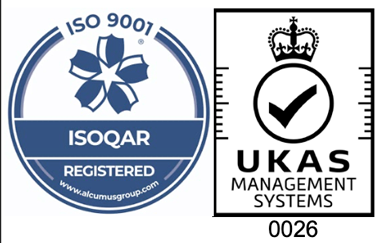Rubber Materials Used at Aquaseal Rubber Ltd
Natural Rubber
Natural rubber is obtained from latex, a natural secretion of certain plants. Latex is composed of long polymer chains which must be partially broken between rollers or rotating blades to soften or grind the rubber before adding compounding ingredients. Compounded rubber is then sheeted, extruded in a specific shape, applied as a coating, or molded for vulcanization.
Aquaseal uses natural rubber in products such as belting, hoses, tubing, insulators, valves, and gaskets. Natural rubber can withstand low temperatures which allow the material to bond easily with metal parts. Additionally, natural rubber parts have a high resistance to tear and abrasion.
Neoprene
Neoprene is the trade name for a group of synthetic rubbers based on polychloroprene. Polychloroprene is composed of chloroprene, acetylene, and hydrochloric acid. Modifying the chemical structure by adding elements yields a broad range of chemical properties. Aquaseal’s material selection and formulation process results in the superior performance of any rubber part.
Neoprene rubber was originally developed as an oil-resistant alternative to natural rubber. The versatility of this rubber, however has proven useful in a wide range of applications. common uses neoprene rubber in industrial applications such as gaskets, hoses, and corrosion-resistant coatings. Neoprene rubber resists damage from sun, ozone, weather, extreme temperature, and flexing or twisting.
Ethylene Propylene Diene Monomer (EPDM) Rubber
EPDM is a synthetic rubber compound that consists primarily of ethylene and propylene. The addition of a small amount of diene allows for the curing of rubber with sulphur, which changes the structure of the chemical structure to that of an unsaturated polymer. EPDM rubber is similar in its properties to Neoprene rubber.
EPDM resists degradation from ozone, oxidants, high temperatures, and extreme weather conditions. Additionally, EPDM rubber has superior colour stability and dielectric ability. Aquaseal Rubber uses EPDM synthetic rubber compounds for both general and specialty outdoor applications, including steam hoses, high temperature-resistant seals, electrical insulation, roll covers, and more.
Styrene Butadiene Rubber (SBR)
Styrene Butadiene Rubber (SBR) is the most common and economical synthetic rubber compound available and is used in a broad range of industrial applications. Styrene butadiene rubber is a polymeride created from styrene and butadiene. Oil refineries derive styrene and butadiene from petroleum, then combine 25% styrene with 75% butadiene to make SBR.
Aquaseal uses SBR in their rubber products because of SBR’s resistance to chemicals, solvents, and extreme heat. SBR is a synthetic compound that can be easily and effectively bonded to an assortment of materials. Because SBR’s properties are also similar to natural rubbers, styrene butadiene rubber can replace natural rubber in many products.
Butyl Rubber
Butyl rubber is a synthetic rubber compound or copolymer composed of isobutylene and isoprene. Isobutylene is a chemical compound consisting of methyl and propylene while isoprene, consisting of menthyl and butadiene, makes the rubber unsaturated and able to vulcanize. Today, Butyl rubber is one of the commonly-used synthetic rubber compounds on the market.
Butyl rubber resists abrasion, oxidation, corrosion, and gas permeation, which allows Butyl rubber to prevent the leakage of gas. Additionally, Butyl rubber has a high dielectric strength. Common applications include inner tubes, o-rings, stoppers for medical bottles, and pharmaceutical supplies.
Fluoroelastomers / VITON® Rubber
Fluoroelastomers are copolymers in a family of synthetic rubber compounds, which, when first introduced, consisted of hexafluoropropylene and vinylidene. Today, the consistency of Fluoroelastomers has been modified to provide even greater thermal stability and solvent resistance. This synthetic rubber compound offers premium, long-lasting reliability in even the harshest environments.
Fluoroelastomers are resistant to chemicals, oil, and heat. Our Fluoroelastomers are used for numerous high-performance applications in the aerospace, automotive, industrial fields, and more. Fluoroelastomers are custom molded into a wide variety of rubber products including seals, o-rings, rubber gaskets, valves, and rubber diaphragms.
Viton® is a registered trademark of Dupont Dow Elastomers L.L.C. Viton® is used in a class of synthetic rubber fluorocarbon elastomers. A copolymer is chosen for the Viton® rubber compound based on the product application. Polymers commonly used are hexafluoropropylene (HFP) and vinylidene fluoride (VDF or VF2), terpolymers of tetrafluoroethylene (TFE), vinylidene fluoride (VDF) and hexafluoropropylene (HFP), and perfluoromethylvinylether (PMVE).
Viton® provides high temperature stability, low compression set, and resistance to chemicals, oil, and ozone. Although Viton® was initially fabricated for the aerospace industry; this rubber compound is also used in fluid power, automotive, appliance, and chemical applications for rubber products such as hoses, seals, o-rings, expansion joints, shaft seals, and rubber gaskets.
Fluoroelastomers
Fluoroelastomers are copolymers in a family of synthetic rubber compounds, which, when first introduced, consisted of hexafluoropropylene and vinylidene. Today, the consistency of Fluoroelastomers has been modified to provide even greater thermal stability and solvent resistance. This synthetic rubber compound offers premium, long-lasting reliability in even the harshest environments.
Fluoroelastomers are resistant to chemicals, oil, and heat. Our Fluoroelastomers are used for numerous high-performance applications in the aerospace, automotive, industrial fields, and more. Fluoroelastomers are custom molded into a wide variety of rubber products including seals, o-rings, rubber gaskets, valves, and rubber diaphragms.
Silicone
Silicone rubber is an inorganic polymer comprising silicone and oxygen. Silicone rubber compounds can be modified through additives including fluorine, phenyl, and vinyl. Fluorine can induce the physical properties inherent in standard silicone and can resist solvents such as fuels. Phenyl improves low temperature flexibility and resists gamma radiation. Vinyl improves the vulcanization qualities as well as the compression set.
Aquaseal’s rubber resists ozone, extreme environmental conditions, radiation, moisture, and chemicals, and can retain structural integrity after the compression set. Additionally, some silicone rubber compounds are flame retardant. Typical custom silicone rubber products include insulators, rubber diaphragms, and impact absorbers. A long service life makes this rubber compound ideal for many industrial applications.
Buna N Rubber
Buna N rubber is a synthetic rubber compound that is also known as standard Nitrile rubber. The compound comprises co-polymers: acrylonitrile and butadiene. Acrylonitrile is a volatile organic liquid. Butadiene is a synthetic chemical compound. When mixed, these two polymers react and produce one of strongest oil-resistant rubber compounds currently available.
Buna N rubber products are resistant to both solvents and oils. Aquaseal Rubber,s molded rubber products that are manufactured with Buna N are appropriate for many industrial applications, including oil hoses, fuel hoses, o-rings, and rubber gaskets. Buna N is similar to Buna S in that it can be vulcanized.


